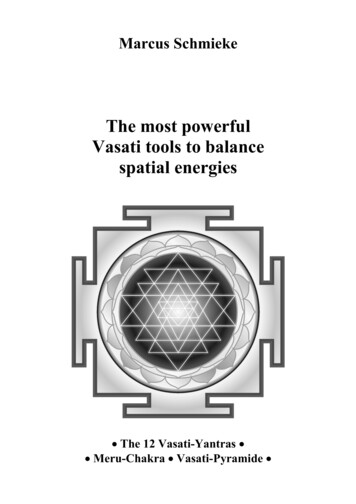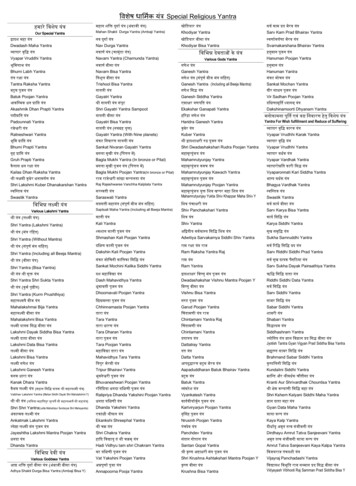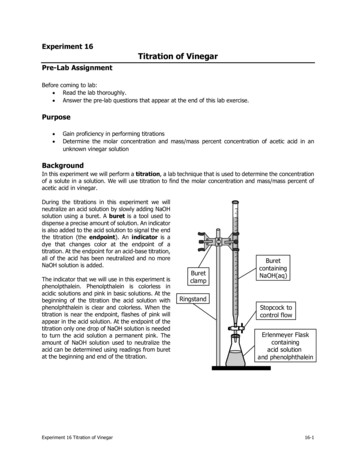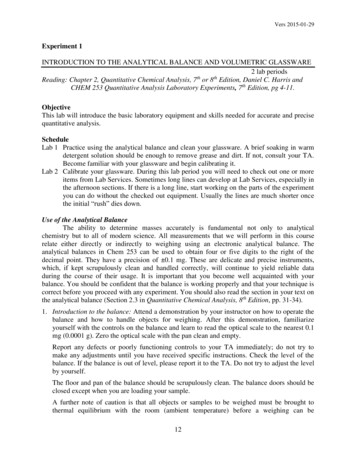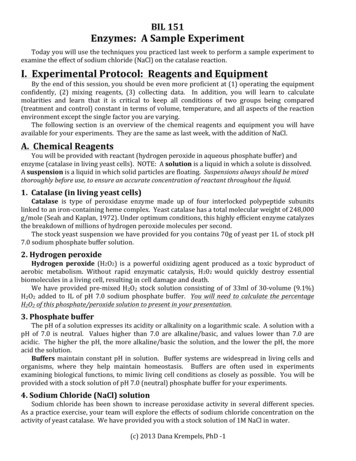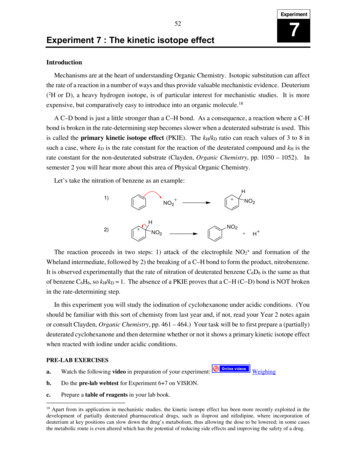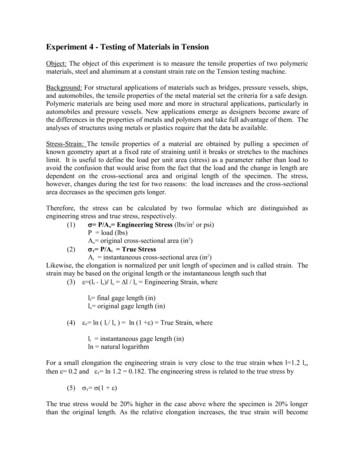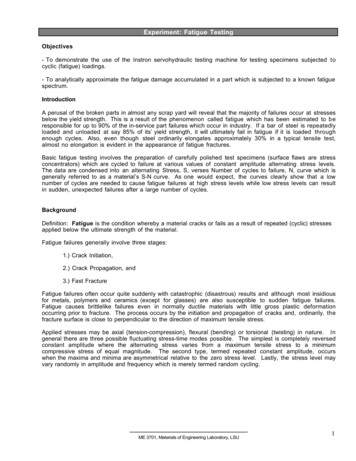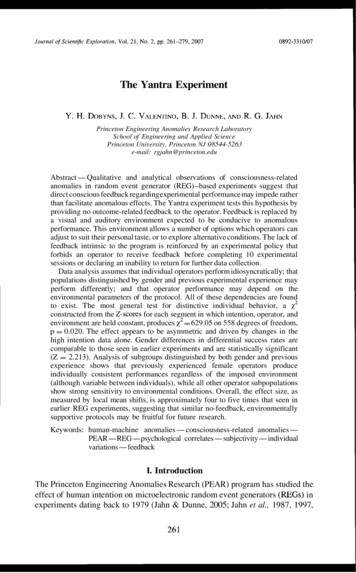
Transcription
The Yantra ExperimentPrinceton Engineering Anomalies Research LaboratorySchool of Engineering and Applied SciencePrinceton University, Princeton NJ 08544-5263e-mail: rgjahn @princeton.eduAbstract-Qualitative and analytical observations of consciousness-relatedanomalies in random event generator (REG)-based experiments suggest thatdirect conscious feedback regarding experimental performance may impede ratherthan facilitate anomalous effects. The Yantra experiment tests this hypothesis byproviding no outcome-related feedback to the operator. Feedback is replaced bya visual and auditory environment expected to be conducive to anomalousperformance. This environment allows a number of options which operators canadjust to suit their personal taste, or to explore alternative conditions. The lack offeedback intrinsic to the program is reinforced by an experimental policy thatforbids an operator to receive feedback before completing 10 experimentalsessions or declaring an inability to return for further data collection.Data analysis assumes that individual operators perform idiosyncratically; thatpopulations distinguished by gender and previous experimental experience mayperform differently; and that operator performance may depend on theenvironmental parameters of the protocol. All of these dependencies are foundto exist. The most general test for distinctive individual behavior, a X2constructed from the 2-scores for each segment in which intention, operator, andenvironment are held constant, produces X2 629.05 on 558 degrees of freedom,p 0.020. The effect appears to be asymmetric and driven by changes in thehigh intention data alone. Gender differences in differential success rates arecomparable to those seen in earlier experiments and are statistically significant(Z 2.213). Analysis of subgroups distinguished by both gender and previousexperience shows that previously experienced female operators produceindividually consistent performances regardless of the imposed environment(although variable between individuals), while all other operator subpopulationsshow strong sensitivity to environmental conditions. Overall, the effect size, asmeasured by local mean shifts, is approximately four to five times that seen inearlier REG experiments, suggesting that similar no-feedback, environmentallysupportive protocols may be fruitful for future research.Keywords: human-machine anomalies-consciousness-related anomaliesPEAR-REG-psychological ackI. IntroductionThe Princeton Engineering Anomalies Research (PEAR) program has studied theeffect of human intention on microelectronic random event generators (REGS) inexperiments dating back to 1979 (Jahn & Dunne, 2005; Jahn et al., 1987, 1997,
262Y. H. Dobyns et al.2000a). Various modes of performance-related feedback have been used over thattime. In the original experiment, feedback was automatic unless the operator went tosome effort to avoid it, since a large and conspicuous front panel on the REG devicedisplayed both the current trial value and a running average for the current collectionof trials. Moreover, since a final run mean was displayed for the operator to record ina logbook, the "no-feedback" condition was maintained only for the duration of thecurrent trial sequence. Subsequent remote experiments with the same equipmentwere run in a genuine no-feedback condition. Alternative modes of graphicalfeedback were introduced in the late 1980s, and proved popular with operators.The initial introduction of graphical feedback seemed not to have significantconsequences for the effect size, except for some operators on an individual basis(Nelson et al., 2000). Later experiments, however, suggested that this might not bea universal generalization. An experiment designed specifically for its appealingfeedback produced no significant results by overall outcome measures (Jahn et al.,2000b), while in the extensive replication effort of the IGPP consortium, graphicalfeedback (chosen as the default mode) actually seemed counterproductive, withtwo of the three participating laboratories reporting statistically significantdifferences of performance in which graphical feedback proved inferior to otherfeedback modes (Jahn et al., 2000a, table M.2). In addition, anecdotal reportsindicated that at least some operators found outcome-related feedback, with itsimplications of evaluation and judgment, to be objectionable and preferred to workwithout feedback of any kind.These considerations led to the design of an experiment that would provide nofeedback regarding experimental outcomes. This design was facilitated by theavailability of a new generation of REG sources without front panel displays. Withthe computer screen relieved of the necessity for a feedback display, it was decidedto use the screen to present an image that it was hoped would be conducive toanomalous performance. The specific choice of image was motivated by theexperience of the "ArtREG" experiment (Jahn et al., 2000b). In that experiment,operators were presented with two superimposed pictures, initially in a "doubleexposure," with half the pixels on the screen coming from each picture. Thebalance between the two images varied under the control of an REG input, andthe operator's intentional task was to make the chosen target image dominatethe screen. While the results of the experiment as a whole were non-significant,there seemed to be a substantial effect size associated with a subset of the images.These images were deemed "numinous," containing significant religious orspiritual imagery from a number of different traditions. After some deliberationit was decided to use a mandala design known as the "Sri Yantra" (see Figure 1) asa numinous visual display to accompany the new experiment.2. The Yantra EnvironmentsThe environmental parameters presented by the Yantra experiment includeoptions for both visual and auditory components intended to facilitate
YantraFig. 1. The Sri Yantra mandala.a meditative state of mind and suppress analytical focus. The Sri Yantra isa pattern of interlocking triangles at the core of Figure 1, a symbol which issupposed to represent the interpenetration of spirit and the material world. Theremainder of the design consists of a series of traditional framing elementscommonly used to surround the Sri Yantra, which also appear frequently in othermandala designs.Operators have three choices of visual environment. The Sri Yantra mandalacan be presented as shown in Figure 1, as a static picture on the computermonitor (in white lines on a blue background screen). Alternatively, sectorsdefined by the various radial boundaries (the surrounding box, the internalcircles bounding the "lotus blossom" patterns, and the Sri Yantra itself) can bepresented in differing background colors, with the colorrnap changing ina steady rhythm driven by arrival of REG trials at the computer. (The values ofthe trials have no effect on this; only their reception by the computer is relevant.)The pattern of specific color changes is chosen by a pseudo-random processunconnected to the experimental data. As a third alternative the monitor cansimply be left blank.Similarly, operators are offered several options for audio environment. Bymeans of a servomotor controlled from an output port and connected toa drumstick, the computer can beat a large Native American drum in theexperiment room. The default audio operation is for the drum to beat once with
264Y. H. Dobyns et al.each data reception event (that is, in the same rhythm as the changes in the videoif changing video is in use). An alternative rhythm beats the drum twice, quickly,with each trial, producing a pattern of quick double beats separated by slightlyless than a second, strongly reminiscent of a heartbeat. A third option is silence,and a fourth allows operators to bring their own music CDs or other recordingmedia to play any soundtrack that appeals to them while doing an experiment.In addition to these various environmental options, another experimentalparameter carried as a variable is the instructed versus volitional assignment ofintention deployed in most of PEAR'S REG-based experiments. There are thustwenty-four possible combinations of intentional assignment, visual environment, and audio environment. These are chosen freely according to the operator's preferences, although operators who explore more than one environmentare encouraged to generate substantial databases in each.3. Experimental ProtocolIn Yantra, as in most PEAR REG experiments, the primary variable isoperator intention: operators actively attempt to shift the REG output distribution in the high and low directions, in a balanced design. The basic unit ofdata collection is a trial of 200 random bits, summed to produce a random7.071. Trialsinteger with theoretical mean 100 and standard deviation &6are produced at a rate slightly faster than 1 per second. Sequences of 100 trialsare generated automatically as runs. The basic unit of operator participation isa series in which an operator completes two runs in the high intention and tworuns in the low intention. This requires approximately 10 minutes in a typicalcase. Unlike the standard REG protocol, Yantra is bipolar rather than tripolar,with no baseline intention. The assignment of intentions to runs may be made bythe operator, or determined by the computer. In the latter case the determinationis made by a pseudo-random process seeded by the time at which the program isstarted. For both volitional and instructed data, the program enforces theconstraint that a series contains exactly two runs of each intention.Since series are quite short, many operators chose to generate multiple series inone session. While operators could, in principle, generate as many or as few seriesas they cared to, the experimental protocol provides no feedback on theirperformance until they either (a) complete at least 10 series, or (b) declare thatthey will not generate any further Yantra data. This policy has the beneficial sideeffect of assuring that small databases from short-term operators could not besubject to optional stopping, since operators had no information about theoutcome of their efforts. While operators could, if they wished, receive feedbackafter their 10th series, several of those who continued to larger databases chose notto be given feedback until they had completed their entire Yantra involvement.When the Yantra experiment was launched it was decided that it would beclosed after 1000 series had been generated. Practical considerations having todo with the availability and enthusiasm of operators, and the desirability of large-
Yantra265operator databases, led to a slight relaxation of this condition, to the stipulationthat the experiment would run at least 1000 series and that after the 1000-seriesmark the experiment would be kept open only for the benefit of operators whowere attempting to complete previously declared commitments regardingpersonal database size. Once these outstanding commitments were completedYantra had generated a total of 1017 formal series. Space precludes thepresentation of the raw data in the current article, but they can be found in theAppendix to the Technical Note on the Yantra experiment (Dobyns et al., 2006).4. Data Analysis MethodsYantra analysis was designed from the outset under the assumption thatoperators would produce individual and idiosyncratic results. Of course,individual 2-scores for operators have always been computed in PEAR experiments; individual variability becomes relevant only when constructing an overall"bottom-line" evaluation for the population of operators. The standard pooled,weighted 2-score test used in earlier experiments is clearly not acceptable underthis hypothesis. It is tantamount to assuming that all operators are interchangeable.While it is the most sensitive possible test for detecting a consistent universaleffect, individual variations are averaged out and become invisible.Given the hypothesized situation of effect sizes that will vary amongindividuals in an unpredictable manner, there is no one statistical test that isoptimally sensitive for all conditions; sensitivity depends on the model ofvariation. A test that is very broadly useful, however, is a X2 test based on the2-scores of components. This is computed by simply squaring the 2-scores of allcomponent databases and summing the squares; the number of degrees offreedom (d.f.) of the X2 is equal to the number of components. Two features ofthis test make it particularly useful and versatile. First, X2 values follow anaddition rule: the sum of two X2 values is another X2 value with a number of d.f.equal to the sum of the d.f. in the two contributions. Second, if the composite Zmentioned above is squared and subtracted from the overall X2,the result is againX2 distributed* with one fewer d.f. This secondary X2 is driven solely by thevariation between subsets, the mean effect having been removed by the 2-scoresubtraction. To express these three quantities mathematically, if there are a totalof N subsets, with the ith subset comprising nidata units and having an aggregate2-score of Zi, the composite 2 , raw X2,and variability X2 can be written:* This is not a general subtraction property for X2;the difference of two X2 is notin general X2 distributed. It can be shown, however, that in this s ecific case,the residual, after subtracting the mean z2from a X2,is in fact x distributed.J'
Y. H. Dobyns et al.26680I0100IIII200300400500Number of Segments (Both Intentions Pooled)Fig. 2. Cumulative plot of ( X 2 - d.f.) for all data segments distinguished by operator, environment,and intention in the Yantra experiment.These equations provide the basic tools for most of the Yantra analyticaltreatments. In addition to inter-operator variability, previous experiments led toan expectation that operators might either
The Sri Yantra mandala can be presented as shown in Figure 1, as a static picture on the computer monitor (in white lines on a blue background screen). Alternatively, sectors defined by the various radial boundaries (the surrounding box, the internal circles bounding the "lotus blossom" patterns, and the Sri Yantra itself) can be presented in differing background colors, with the colorrnap .
